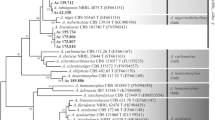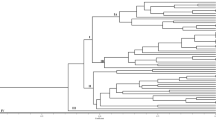Abstract
Aspergillus flavus strains were isolated frompeanut fields of Liaoning, Shandong, Hubei and Guangdong Provinces in China, and identified through phenotypic and molecular approaches. Of the 323 A. flavus strains isolated, 76 strains did not produce aflatoxins detectable by UPLC. The incidence of atoxigenic A. flavus strains decreased with increase in temperature and increased with increase in latitude in different geographical locations. Amplification of all the aflatoxin genes in the aflatoxin gene cluster in the atoxigenic isolates showed that there were 25 deletion patterns (A–Y), with 22 deletion patterns identified for the first time. Most of the atoxigenic A. flavus isolates with gene deletions (97%) had deletions in at least one of the four genes (aflT, nor-1, aflR, and hypB), indicating that these four genes could be targeted for rapid identification of atoxigenic strains. The atoxigenic isolates with gene deletions, especially the isolates with large deletions, are potential candidates for aflatoxin control.
Similar content being viewed by others
Refrerences
Barros, G.G., Chiotta, M.L., Reynoso, M.M., Torres, A.M., and Chulze, S.N. 2007. Molecular characterization of Aspergillus section Flavi isolates collected from peanut fields in Argentina using AFLPs. J. Appl. Microbiol. 103, 900–909.
Brown, R.L., Chen, Z.Y., Cleveland, T.E., and Russin, J.S. 1999. Advances in the development of host resistance in corn to aflatoxin contamination by Aspergillus flavus. Phytopathology 89, 113–117.
Chang, P.K., Horn, B.W., and Dorner, J.W. 2005. Sequence breakpoints in the aflatoxin biosynthesis gene cluster and flanking regions in nonaflatoxigenic Aspergillus flavus isolates. Fungal Genet. Biol. 42, 914–923.
Chang, P.K., Wilkinson, J.R., Horn, B.W., Yu, J., Bhatnagar, D., and Cleveland, T.E. 2007. Genes differentially expressed by Aspergillus flavus strains after loss of aflatoxin production by serial transfers. Appl. Microbiol. Biotechnol. 77, 917–925.
Chang, P.K., Yu, J., Bhatnagar, D., and Cleveland, T.E. 1999. The carboxy-terminal portion of the aflatoxin pathway regulatory protein AFLR of Aspergillus parasiticus activates GAL1: lacZ gene expression in Saccharomyces cerevisiae. Appl. Environ. Microbiol. 65, 2508–2512.
Cotty, P.J. 1994. Comparison of four media for the isolation of Aspergillus flavus group fungi. Mycopathologia 125, 157–162.
Cotty, P.J. 1997. Aflatoxin-producing potential of communities of Aspergillus section Flavi from cotton producing areas in the United States. Mycol. Res. 101, 698–704.
Criseo, G., Bagnara, A., and Bisignano, G. 2001. Differentiation of aflatoxin-producing and non-producing strains of Aspergillus flavus group. Lett. Appl. Microbiol. 33, 291–295.
Das, M.K., Ehrlich, K.C., and Cotty, P.J. 2008. Use of pyrosequencing to quantify incidence of a specific Aspergillus flavus strain within complex fungal communities associated with commercial cotton crops. Phytopathology 98, 282–288.
Donner, M., Atehnkeng, J., Sikora, R.A., Bandyopadhyay, R., and Cotty, P.J. 2010. Molecular characterization of atoxigenic strains for biological control of aflatoxins in Nigeria. Food Addit. Contam. Part A. 27, 576–590.
Dorner, J.W. 2004. Biological control of aflatoxin contamination of crops. Toxin Rev. 23, 425–450.
Dorner, J.W. and Cole, R.J. 2002. Effect of application of nontoxigenic strains of Aspergillus flavus and A. parasiticus on subsequent aflatoxin contamination of peanuts in storage. J. Stored Prod. Res. 38, 329–339.
Dorner, J.W., Cole, R.J., Connick, W.J., Daigle, D.J., McGuire, M.R., and Shasha, B.S. 2003. Evaluation of biological control formulations to reduce aflatoxin contamination in peanuts. Biological. Control. 26, 318–324.
Egmond, H.P. 1989. Current situation on regulations for mycotoxins. Overview of tolerances and status of standard methods of sampling and analysis. Food Addit. Contam. 6, 139–188.
Egmond, H.P. and Jonker, M.A. 2004. Worldwide regulations on aflatoxins-the situation in 2002. J. Toxicol. Toxin. Rev. 23, 273–293.
Egmond, H.P., Schothorst, R., and Jonker, M. 2007. Regulations relating to mycotoxins in food: Perspectives in a global and European context. Anal. Bioanal. Chem. 389, 147–157.
Ehrlich, K.C. 2009. Predicted roles of the uncharacterized clustered genes in aflatoxin biosynthesis. Toxins 1, 37–58.
Ehrlich, K.C., Chang, P.K., Yu, J., and Cotty, P.J. 2004. Aflatoxin biosynthesis cluster gene cypA is required for G aflatoxin formation. Appl. Environ. Microbiol. 70, 6518–6524.
Ehrlich, K.C. and Cotty, P.J. 2004. An isolate of Aspergillus flavus used to reduce aflatoxin contamination in cottonseed has a defective polyketide synthase gene. Appl. Microbiol. Biotechnol. 65, 473–478.
Gao, J., Liu, Z., and Yu, J. 2007. Identification of Aspergillus section Flavi inmaize in northeastern China. Mycopathologia 164, 91–95.
Garber, R.K. and Cotty, P.J. 1997. Formation of sclerotia and aflatoxins in developing cotton bolls infected by the S strain of Aspergillus flavus and potential for biocontrol with an atoxigenic strain. Phytopathology 87, 940–945.
Giorni, P., Magan, N., Pietri, A., Bertuzzi, T., and Battilani, P. 2007. Studies on Aspergillus section Flavi isolated from maize in northern Italy. Int. J. Food Microbiol. 113, 330–338.
Guan, S., Ji, C., Zhou, T., Li, J., Ma, Q., and Niu, T. 2008. Aflatoxin B1 degradation by Stenotrophomonas maltophilia and other microbes selected using coumarin medium. Int. J. Mol. Sci. 9, 1489–1503.
Guzmán-de-Peña, D. and Peña-Cabriales, J.J. 2005. Regulatory considerations of aflatoxin contamination of food in Mexico. Rev. Latinoam. Microbiol. 47, 160–164.
Inan, F., Pala, M., and Doymaz, I. 2007. Use of ozone in detoxification of aflatoxin B1 in red pepper. J. Stored Prod. Res. 43, 425–429.
Jaime-Garcia, R. and Cotty, P.J. 2006. Spatial relationships of soil texture and crop rotation to Aspergillus flavus community structure in South Texas. Phytopathology 96, 599–607.
Kabak, B. 2009. The fate of mycotoxins during thermal food processing. J. Sci. Food Agr. 89, 549–554.
Mauro, A., Battilani, P., Callicott, K.A., Giorni, P., Pietri, A., and Cotty, P.J. 2013. Structure of an Aspergillus flavus population from maize kernels in northern Italy. Int. J. Food. Microbiol. 162, 1–7.
Mayer, Z., Bagnara, A., Färber, P., and Geisen, R. 2003. Quantification of the copy number of nor-1, a gene of the aflatoxin biosynthetic pathway by real-time PCR, and its correlation to the cfu of Aspergillus flavus in foods. Int. J. Food.Microbiol. 82, 143–151.
Payne, G.A. and Brown, M.P. 1998. Genetics and physiology of aflatoxin biosynthesis. Annu. Rev. Phytopathol. 36, 329–362.
Pildain, M.B., Vaamonde, G., and Cabral, D. 2004. Analysis of population structure of Aspergillus flavus from peanut based on vegetative compatibility, geographic origin, mycotoxin and sclerotia production. Int. J. Food Microbiol. 93, 31–40.
Price, M.S., Yu, J., Nierman, W.C., Kim, H.S., Pritchard, B., Jacobus, C.A., Bhatnagar, D., and Cleveland, T.E. 2006. The aflatoxin pathway regulator AflR induces gene transcription inside and outside of the aflatoxin biosynthetic cluster. FEMS Microbiol. Lett. 255, 275–279.
Razzaghi-Abyaneh, M., Shams-Ghahfarokhi, M., Allameh, A., Kazeroon-Shiri, A., Ranjbar-Bahadori, S., Mirzahoseini, H., and Rezaee, M.B. 2006. A survey on distribution of Aspergillus section Flavi in corn field soils in Iran: population patterns based on aflatoxins, cyclopiazonic acid and sclerotia production. Mycopathologia 161, 183–192.
Rodrigues, P., Santos, C., Venancio, A., and Lima, N. 2011. Species identification of Aspergillus section Flavi isolates from Portuguese almonds using phenotypic, including MALDI-TOF ICMS, and molecular approaches. J. Appl. Microbiol. 111, 877–892.
Rodrigues, P., Venâncio, A., Kozakiewicz, Z., and Lima, N. 2009. A polyphasic approach to the identification of aflatoxigenic and non-aflatoxigenic strains of Aspergillus Section Flavi isolated from Portuguese almonds. Int. J. Food.Microbiol. 129, 187–193.
Schmidt-Heydt, M., Magan, N., and Geisen, R. 2008. Stress induction of mycotoxin biosynthesis genes by abiotic factors. FEMS Microbiol. Lett. 284, 142–149.
Trail, F., Chang, P.K., Cary, J., and Linz, J.E. 1994. Structural and functional analysis of the nor-1 gene involved in the biosynthesis of aflatoxins by Aspergillus parasiticus. Appl. Environ. Microbiol. 60, 4078–4085.
Tubajika, K.M. and Damann, K.E. 2001. Sources of resistance to aflatoxin production in maize. J. Agr. Food Chem. 49, 2652–2656.
Vaamonde, G., Patriarca, A., Fernández Pinto, V., Comerio, R., and Degrossi, C. 2003. Variability of aflatoxin and cyclopiazonic acid production by Aspergillus section Flavi from different substrates in Argentina. Int. J. Food. Microbiol. 88, 79–84.
Woloshuk, C.P., Foutz, K.R., Brewer, J.F., Bhatnagar, D., Cleveland, T.E., and Payne, G.A. 1994. Molecular characterization of aflR, a regulatory locus for aflatoxin biosynthesis. Appl. Environ. Microbiol. 60, 2408–2414.
Yin, Y., Lou, T., Yan, L., Michailides, T.J., and Ma, Z. 2009. Molecular characterization of toxigenic and atoxigenic Aspergillus flavus isolates, collected from peanut fields in China. J. Appl. Microbiol. 107, 1857–1865.
Yin, Y., Xin, L., Ma, Z., and Yan, Y. 2010. The primer sequences and methods for multiplex PCR to identify atoxigenic strains. China Patent, CN 101701250A.
Yu, J., Chang, P.K., Ehrlich, K.C., Cary, J.W., Bhatnagar, D., Cleveland, T.E., Payne, G.A., Linz, J.E., Woloshuk, C.P., and Bennett, J.W. 2004a. Clustered pathway genes in aflatoxin biosynthesis. Appl. Environ. Microbiol. 70, 1253–1262.
Yu, J., Whitelaw, C.A., Nierman, W.C., Bhatnagar, D., and Cleveland, T.E. 2004b. Aspergillus flavus expressed sequence tags for identification of genes with putative roles in aflatoxin contamination of crops. FEMS Microbiol. Lett. 237, 333–340.
Zhang, C.S., Xing, F.G., Selvaraj, J.N., Yang, Q.L., Zhou, L., Zhao, Y.J., and Liu, Y. 2013. The effectiveness of ISSR profiling for studying genetic diversity of Aspergillus flavus from peanutcropped soils in China. Biochem. Syst. Ecol. 50, 147–153.
Zhou, R. and Linz, J.E. 1999. Enzymatic function of the Nor-1 protein in aflatoxin biosynthesis in Aspergillus parasiticus. Appl. Environ. Microbiol. 65, 5639–5641.
Author information
Authors and Affiliations
Corresponding author
Rights and permissions
About this article
Cite this article
Wei, D., Zhou, L., Selvaraj, J.N. et al. Molecular characterization of atoxigenic Aspergillus flavus isolates collected in China. J Microbiol. 52, 559–565 (2014). https://doi.org/10.1007/s12275-014-3629-8
Received:
Revised:
Accepted:
Published:
Issue Date:
DOI: https://doi.org/10.1007/s12275-014-3629-8




